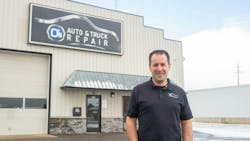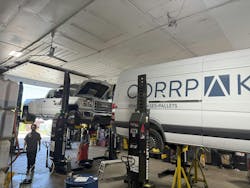Repair management platform allows truck shop to grow revenue without adding bays
Switching from manual recordkeeping to repair shop platform is a big transition, but Daris DeGroot, owner of D’s Auto & Truck Repair, has seen plenty of benefits of making the switch. He was an early adopter of Shop4D in 2018 and hasn’t looked back.
According to Shop4D, the software improves efficiency from end to end, allowing shops to integrate parts sourcing into the work order write-up to speed up estimates, recommend preventive maintenance based on vehicle history and technical service bulletins to help service advisors sell more work, and streamline payments as well.
Maybe it should be called “Shop for D’s,” as it seems tailored to improve the entire repair process for the Holland, Michigan operation. Primarily, it has allowed the shop, which services passenger and light- and medium-duty commercial vehicles, to increase revenue without needing to expand to a second shop.
“Service advisors are estimating quicker, sourcing parts quicker, putting out fires quicker,” DeGroot explained. “Techs are fixing the car quicker, which opens our bays up more, which means, instead of expanding, we're trying to maximize the bays that we have. We're increasing [vehicle] count with less need for a bigger shop.”
4D chess moves
Shop4D was developed by Terry Keller, a former ASE Master Certified technician and owner of Keller Bros. Repair in Littleton, Colorado, who now serves as the company’s chairman. He co-founded the platform with David Rogers, now Shop4D’s CEO, after the two worked together at a consulting business for shops called Auto Profit Masters.
The two first worked together at a consulting business for shops called Auto Profit Masters. There they developed RPM Toolkit, a shop management software that serves as a diagnostic tool for the business side of a shop. It synchs with a shop’s point-of-sale system to measure shop performance and customer data, ultimately allowing managers to get to the root cause of redundancies and inefficiencies. In 2018, they expanded this by launching Shop4D to optimize the overall repair workflow.
“We developed Shop4D in our repair shop, Keller Bros., with direct input from our service advisors and technicians,” Keller said. “The goal was straightforward: make it easier for technicians to inspect and write up vehicles and make it easier for service advisors to estimate and advise tickets.”
Keller added that between Rogers and himself, they have 50 years of shop management experience, and “we were well aware of the challenges [of other shop management platforms] and ready to solve them.”
This led to creating the user-friendly tool that connects vehicle inspection reports, service write-ups, parts supplier sites, and labor guides.
“Shop4D has had built-in AI from the start; techs can see and request commonly used parts for that repair with a single click,” Keller noted.
Putting Shop4D into practice
DeGroot was an early adopter of Shop4D and picked up the platform in the summer of 2018 after learning about it through his work with Keller and Rogers’ Auto Profit Masters. In particular, he said he’d found it helpful for his team’s inspections, labor guides, vehicle reports, and metrics reporting.
One of the primary features of Shop4D is its vehicle inspection and write-ups software, which the company claims lets each technician bill an average of two more hours each day.
“From the tech side, the inspection is very thorough,” DeGroot agreed.
Not only does Shop4D’s system help him make sure inspections are consistent every time a vehicle enters the shop, but it’s also increased their accountability, the shop owner said. This is partially because the platform allows technicians to add pictures to each vehicle’s inspection report.
“Whether the technician made a mistake or not, we want to be as sure as we can be,” he affirmed. Additionally, saving vehicle photos in Shop4D helps build a vehicle history, so that they can look for repair trends and make sure customers are staying on top of their PMs.
“We can see accident history, we can see service stuff that's been reported,” he said. “We can see from the technician and service advisor what the maintenance schedules and recommendations are, so that we can be making those advisements.”
Plus, the thorough inspection process helps protect the shop from liability.
According to DeGroot, the ability to take pictures of the vehicles “has saved us quite a few times when we've been accused of denting or scratching cars, [because] we can actually see the dent in the pictures. And then, because Shop4D tracks each step of the process, it timestamps it.”
Then, from the inspection, Shop4D auto-populates suggested jobs and parts. DeGroot credits this for more accurate estimates, better labor guides, and less downtime caused by miscommunication.
“Having a process that's very streamlined, and we do it the same way every time, helps us eliminate those types of things,” he added.
Finally, Keller emphasized how Shop4D can help shops manage their metrics.
“Managing a shop shouldn’t have to take a huge investigation each day to identify that day’s focus, and with Shop4D it doesn’t have to,” Keller asserted. “This means [shops need access to] KPIs focused on measuring how well your technicians are inspecting vehicles, and how effective the service advisors are at educating customers about the recommendations the technicians have made.”
DeGroot agreed that his shop has leveraged Shop4D to keep track of his business from a bird’s eye view, allowing them to process payroll, technician efficiency, and service advisor metrics.
“Any targets that we have, such as key performance indicators, things like that, those are reviewed daily by me,” DeGroot noted. “The biggest gain that we saw, right off the bat, and continue to see, is we can see if a technician is underperforming very quickly.”
This means being able to see everything from how well a technician is filling out their inspections, if they’re correctly identifying key repair areas, and looking at their billable hours.
“Shop 4D automatically tracks the time that they're there, as long as they punch in and out properly, our bookkeeper will send them an internal report from Shop 4D that they can approve or deny, and they can ask for corrections to the bookkeeper,” DeGroot explained. Then, if a technician’s work output is low, they can dive into why that is and see how they can help them.
As an example, DeGroot described how he had a long-standing diagnostic technician who generally billed a lot of hours. But after a few weeks of low numbers, they were able to find out that he’d gotten several complicated repairs, with some still waiting on parts.
For DeGroot, the real payoff has been visibility, with D’s now being able to see exactly where the maintenance team excels and where they need support. “We could quickly identify what was going on and how we can improve,” he said.
About the Author

Alex Keenan
Alex Keenan is an Associate Editor for Fleet Maintenance magazine. She has written on a variety of topics for the past several years and recently joined the transportation industry, reviewing content covering technician challenges and breaking industry news. She holds a bachelor's degree in English from Colorado State University in Fort Collins, Colorado.

